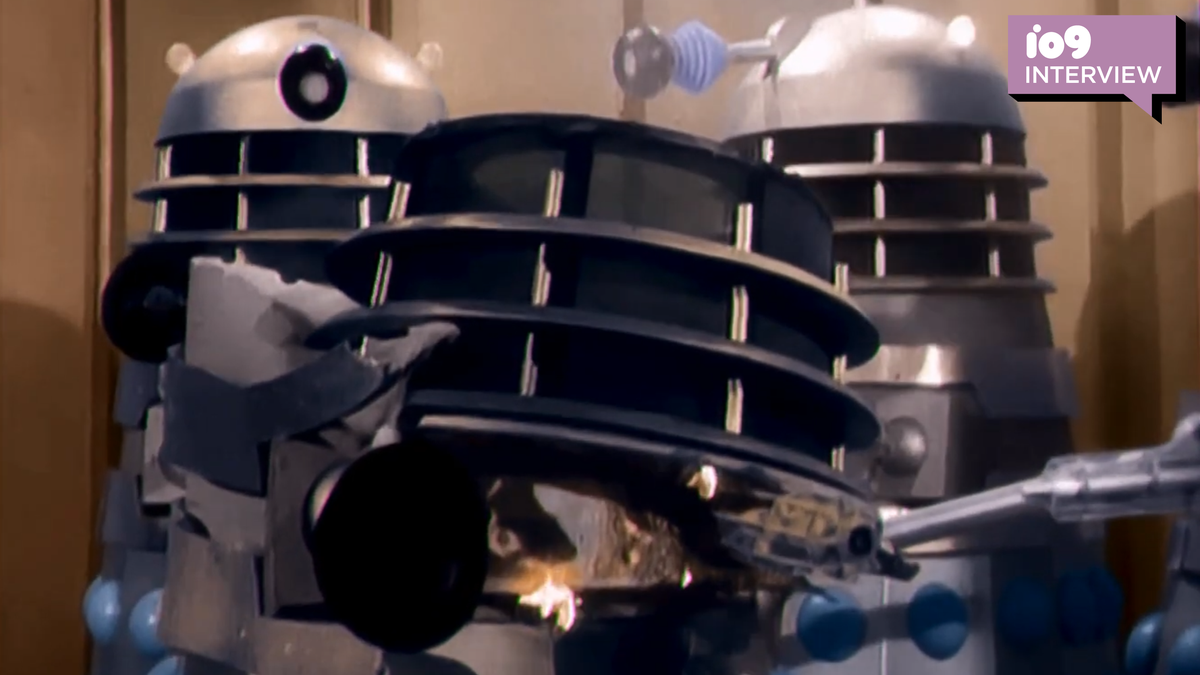
“I kept meeting younger Doctor Who fans that wouldn’t give the ‘60s era a go. I found this difficult to process because for me it’s the golden age of the show. Some people just don’t connect with black and white—so I thought I’d do something about it,” Tipple added, explaining why he started colorizing clips from the series. “As soon as you add color something magical happens. A clip you’ve seen a hundred times before suddenly feels new. It’s like watching something for the first time. It breathes new life into something familiar. Sometimes when you’re in the middle of things it’s hard to see the wood through the trees. Perhaps I’ve spent eight hours coloring a bronze button on the Doctor’s coat… when I zoom out and watch everything back I’m like, ‘hey, that works!’ It’s time consuming but that’s what makes it rewarding!”
Tipple’s passion for restoring classic Doctor Who is something he’s been able to spin into part of his career as well, helping the BBC’s home release of Doctor Who season eight—Jon Pertwee’s second season as the third incarnation of the Doctor. Although it wasn’t quite Tipple’s usual colorization work, building on original black-and-white material (Doctor Who debuted in color in 1970’s season seven, when Pertwee joined the series), it was still a chance to work on one of his favorite shows. “It was a huge honor to be involved in the season eight Blu-ray release. The BBC were encountering some issues with the color on a 1971 Jon Pertwee story called ‘The Dæmons.’ It’s a story that has had all manner of ingenious color recovery thrown at it, So I was building on top of some excellent color work but some scenes still required manual intervention. I worked with Gav Rymill, Anthony Lamb and Kieran Highman, so a real team effort! The whole process was amazing. I kept pinching myself. To use my colourisation skills to help restore ‘The Dæmons’ to how it looked when originally broadcast was thrilling.”
But beyond his chance to work on the show officially, Tipple has started sharing his passion for restoring Doctor Who online by painstakingly working on bringing clips from classic stories like “The Dalek Invasion of Earth” and others to life in color. Even working as just a single fan, it’s an arduous process. “You always start a colorization by looking for source material. Are there any behind the scenes color photos of the sets? Were any props reused during the color era? This stuff is vital as it allows you to pick the correct colors out,” Tipple said of the process. Being faithful to the original is just one step, but given Doctor Who’s shaky archival history in its earliest days, proof of costume colors or set decoration isn’t always going to be easy to find.
“Of course you’ll never get a reference for everything and you do have to use some artistic license. It’s important to be creative, and use a pallet that works tonally. The 1960s was a vivid, technicolor decade and I like that reflected in my work,” Tipple continued. “There’s an age-old debate about the TARDIS console too. It was painted green so that it would appear white on a monochrome television set. So at this point do you go with the authentic color of the prop, or go with what the production team wanted to achieve? I don’t think there’s a wrong answer but I’ve definitely favoured a subtle green coloring.”
G/O Media may get a commission
Tipple sees his work, fan project or not, as something the BBC’s slowly been getting into lockstep with in recent years as it seeks to recover as much of Doctor Who’s lost early history as possible. It’s a way to celebrate the earliest era of a sci-fi legend, breathe new life into it for younger audiences, and preserve it as it was imagined to be seen by its cast and creators all those years ago. “I think as a community [Doctor Who fans] are so well looked after. I can’t think of another franchise, bar possibly Monty Python, that gets half the love and energy that Doctor Who releases get. The people that put this stuff together really care about the show. They go above and beyond. Even now, nearly 60 years since the first episode, people are still unearthing new information,” Tipple reflected. “It’s incredible. Some things are lost, and some will never come back, but the fans are keeping it alive. It’s brilliant to see the BBC animating things like ‘Evil of the Daleks’ and ‘Galaxy Four,’ two stories I never thought I’d have on my DVD shelf!”
As the BBC works to restore—and where it can’t, re-animate—classic stories lost to time (and space!), Tipple remains hopeful as a fan that there’s still more joy to be found in revisiting the series’ earliest days like this. “The future for the classic Doctor Who range is in safe hands and as a fan, I’m excited to see what the future brings. We’ve cleaned up old prints, we’ve restored the sound, we’ve vidfired the picture… as technology improves perhaps we’ll see Hartnell in HD! Maybe we’ll get the whole 1960s era in colour—who knows! Even today we’re seeing things that 10 years ago I wouldn’t have thought possible, so we really can’t rule anything out.”
Advertisement
You can see more of Tipple’s restoration and colorization work on his Twitter account.
Wondering where our RSS feed went? You can pick the new up one here.
Advertisement